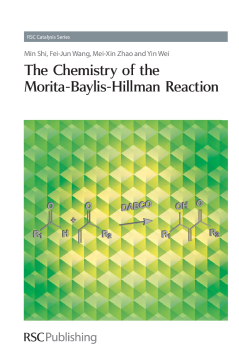
BOOK
The Chemistry of the Morita-Baylis-Hillman Reaction
James J Spivey | Min Shi | Feijun Wang | Mei-Xin Zhao | Yin Wei
(2011)
Additional Information
Book Details
Abstract
Carbon-carbon bond formations and functional group transformations are the most fundamental reactions for the construction of molecular frameworks and are at the forefront of organic chemistry research. The Morita-Baylis-Hillman (MBH) type reactions possess the two most important requirements - atom economy and generation of multi-functional groups. The last decade has seen exponential growth of the MBH reaction and its applications. In fact, it is already one of the most powerful carbon-carbon bond-forming methods widely used in organic synthesis. Since the 1990s, more and more research groups have initiated work on different aspects of the MBH reaction. These have focused on the scope of the substrates, novel catalysts (especially chiral catalysts), reaction mechanisms, and synthetic applications. Consequently, there is now a need for a reference detailing the chemistry of this important reaction. This unique book summarizes the MBH reaction, aza-MBH reaction and asymmetric MBH/aza-MBH reaction including the latest research and mechanistic investigations. It provides a complete overview of MBH-type reactions aimed at synthetic organic chemists of all levels within academia and industry. The chapters cover the; origin and growth of the Morita-Baylis-Hillman reaction; reactant classes and reaction conditions; catalytic mechanisms; achiral and chiral catalytic systems; transformations of functional groups; use of Morita-Baylis-Hillman adducts and derivatives as starting materials to construct compounds with carbocyclic or heterocyclic frameworks, and the applications of the MBH reaction in synthesizing natural products.
Min Shi has been a professor of organic chemistry in the State Key Laboratory of Organometallic Chemistry at the Shanghai University of Organic Chemistry (SIOC) within the Chinese Academy of Science for the past ten years. Professor Shi's research focuses on the organic synthesis, asymmetric catalysis, organocatalysis, and chemical fixation of CO2. With twenty years experience in the field, Min Shi has published over 300 articles in the most prestigious publications in the field and is also regularly invited to review articles submitted for publication in many academic journals. Feijun Wang obtained a BSc and MSc from the China University of Mining and Technology. After receiving his PhD (on the synthesis of novel ozaloline ligands with a biphenyl backbone and their applications in asymmetric catalysis) from the Shanghai Jiao Tong University School of Chemistry and Technology, he joined the group of Professor Min Shi. His research now focuses on the development of novel rotation restricted ligands and their applications in asymmetric catalysis.
